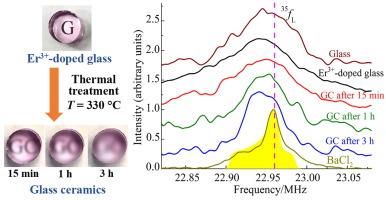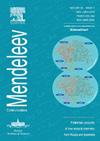35Cl核磁共振监测氟锆酸盐玻璃的结晶行为
IF 1.7
4区 化学
Q3 CHEMISTRY, MULTIDISCIPLINARY
引用次数: 0
摘要
首次采用35Cl核磁共振(NMR)技术研究了掺铒氟氯锆酸盐玻璃在ZrF4-BaF2-BaCl2-LaF3-AlF3-NaF体系中的结晶过程。结果表明,结晶导致氯原子电子结构的均匀性增加,核磁共振谱线变窄。当玻璃结晶时,铒离子被置换到氟相中。本文章由计算机程序翻译,如有差异,请以英文原文为准。

Crystallization behavior of fluorozirconate glasses as monitored by 35Cl NMR
The 35Cl nuclear magnetic resonance (NMR) spectroscopy was first used to study the crystallization of erbium-doped fluorochlorozirconate glass in the ZrF4–BaF2–BaCl2–LaF3–AlF3–NaF system. It has been shown that crystallization results in the increasing homogeneity of electronic structure on chlorine atoms and a narrowing of the NMR line. The glass being crystallized, erbium cations are displaced into the fluoride phase.
求助全文
通过发布文献求助,成功后即可免费获取论文全文。
去求助
来源期刊

Mendeleev Communications
化学-化学综合
CiteScore
3.00
自引率
21.10%
发文量
226
审稿时长
4-8 weeks
期刊介绍:
Mendeleev Communications is the journal of the Russian Academy of Sciences, launched jointly by the Academy of Sciences of the USSR and the Royal Society of Chemistry (United Kingdom) in 1991. Starting from 1st January 2007, Elsevier is the new publishing partner of Mendeleev Communications.
Mendeleev Communications publishes short communications in chemistry. The journal primarily features papers from the Russian Federation and the other states of the former USSR. However, it also includes papers by authors from other parts of the world. Mendeleev Communications is not a translated journal, but instead is published directly in English. The International Editorial Board is composed of eminent scientists who provide advice on refereeing policy.
 求助内容:
求助内容: 应助结果提醒方式:
应助结果提醒方式:


